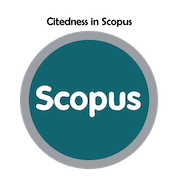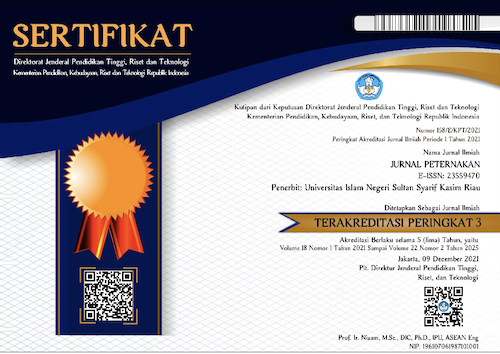The Effect of the Addition of Sugar Liquid on the Development of Bees (Apis mellifera) in a Regular Box
Abstract
ABSTRACT. Sugar liquid can be used as supplementary feed for honeybees (Apis mellifera) because it may influence population development, egg production, and larvae, thereby enhancing colony productivity. This study aimed to determine the effect of adding sugar liquid on the development of Apis mellifera populations in standard hives. The research utilized 12 standard hives of Apis mellifera, each containing seven frames, with sugar liquid applied in four different treatments and three replicates. The treatments involved sugar liquid at a ratio of 3:1 (3 parts sugar and 1 part water), with levels of P0 = 0 kg, P1 = 0.33 kg/week, P2 = 0.66 kg/week, and P3 = 1 kg/week. The study employed a randomized block design (RBD), and data were analyzed using variance (ANOVA). Significant differences between treatments were further tested using Duncan's test. The results indicated that the addition of sugar liquid as supplementary feed did not significantly affect (P>0.05) the population, egg number, or larvae count of Apis mellifera. The study concludes that adding up to 1 kg of sugar liquid per week meets the basic nutritional needs of Apis mellifera but is not sufficiently effective in significantly increasing population, egg, or larval numbers.
Keywords
Full Text:
PDFReferences
Abadi, H. R. K. S., H. A. Shahryar, A. S. Teli, & R. S. Nobar. 2018. Impact of various carbohydrate sources on functional attributes, colony population, feed intake, and quality of honey produced by the honeybee. Kafkas Universitesi Veteriner Fakultesi Dergisi. 24(4): 503-510.
Amiri, E., K. Le., C. V. Melendez., M. K. Strand., D. R. Tarpy, & O. Rueppell. 2020. Egg‐size plasticity in Apis mellifera: Honeybee queens alter egg size in response to both genetic and environmental factors. J. Evol. Biol. 33(4): 534-543.
Brys, M. S., & A. Strachecka. 2024. The key role of amino acids in pollen quality and honeybee physiology—A review. Molecules. 29(11): 2-15.
Dequenne, I., J. M. P. de Foy, & P. D. Cani. 2022. Developing strategies to help bee colony resilience in changing environments. Animals. 12(23): 2-16
Di Pasquale, G., C. Alaux., Y. Le Conte., J. F. Odoux, M. Pioz., B. E. Vaissière, & A. Decourtye. 2016. Variations in the availability of pollen resources affect honeybee health. PloS One. 11(9): 1-15.
Ghosh, S., C. Jung, & V. B. Meyer-Rochow. 2016. Nutritional value and chemical composition of larvae, pupae, and adults of worker honeybee, Apis mellifera ligustica as a sustainable food source. J. Asia-Pacific Entomol. 19(2): 487-495.
Guler, A., D. Ekinci., S. Biyik., A. V. Garipoglu., H. Onder, & H. Kocaokutgen. 2018. Effects of feeding honeybees (Hymenoptera: Apidae) with industrial sugars produced by plants using different photosynthetic cycles (carbon C3 and C4) on the colony’s wintering ability, lifespan, and forage behavior. J. Economic Entomol. 111(5): 2003-2010.
Hendriksma, H. P., A. L. Toth, & S. Shafir. 2019. Individual and colony level foraging decisions of bumble bees and honeybees in relation to balancing of nutrient needs. Front. Ecol. Evol. 7(177): 1-12.
Kluska, K., K. Piotrowicz, & I. Kasprzyk. 2020. The impact of rainfall on the diurnal patterns of atmospheric pollen concentrations. Agricul. Forest Meteorol. 291(7): 108042.
Kratz, M., R. Manning, K. Dods, B. Baer, & D. Blache. 2024. Nurse bees regulate the larval nutrition of developing workers (Apis mellifera) when feeding on various pollen types. J. Economic Entomol. 117(3): 683-695.
Marcelino, J., C. Braese., K. Christmon., J. D Evans., T. Gilligan., T. Giray., A. Nearman., E. L. Niño., R. Rose., W. S. Sheppard., D. vanEngelsdorp, and J. D. Ellis. 2022. The Movement of Western HoneyBees (Apis mellifera L.) Among U.S. States and Territories: History, Benefits, Risks, and Mitigation Strategies. Front. Ecol. Evol. 10:850600. doi: 10.3389/fevo.2022.850600
Macivor, J. S. 2017. Cavity-nest boxes for solitary bees: A century of design and research. Apidologie. 48(3): 311-327.
Mayaut, G., M. Nindatu, & R. H. de Kock. 2020. Differences in metamorphosis of honeybees Apis mellifera in Romang Island. Rumphius Pattimura Biological J. 2(2): 056-059.
Mubarok, M. F. Z., M. F. Wadjdi, & O. R. Puspitarini. 2020. Pengaruh berbagai ukuran sel ratu buatan terhadap larva lolos hidup, larva jadi pupa, dan panjang pupa pada lebah Apis mellifera. Jurnal Rekasatwa Peternakan. 3(1): 50–54.
Murcia-Morales, M., F. Vejsnæs., R. Brodschneider., F. Hatjina., J. J. Van der Steen., J. L. Oller-Serrano, & A. R. Fernández-Alba. 2023. Enhancing the environmental monitoring of pesticide residues through Apis mellifera colonies: Honeybees versus passive sampling. Sci. Total Environment. 884(163847): 1-11.
Posada-Florez, F., Z. S. Lamas., D. J. Hawthorne., Y. Chen., J. D. Evans, & E. V. Ryabov. 2021. Pupal cannibalism by worker honeybees contributes to the spread of deformed wing virus. Sci. Rep. 11(8): 1-11.
Radev, Z. 2018. The impact of different protein content of pollen on honeybee (Apis mellifera L.) development. American J. Entomol. 2(3): 23-27.
Rompas, J. J. I. 2015. Tambahan pakan buatan (gula tebu dan aren) terhadap produksi royal jelly lebah madu Apis cerana. Jurnal LPPM Bidang Sains Dan Teknologi. 2(1): 62-72.
Setiawan, A., T. Susdiyanti, & K. B. Meiganati. 2021. Produktivitas lebah Trigona sp. pada berbagai teknik budidaya di Desa Nayagati, Kecamatan Leuwidamar, Kabupaten Lebak. Jurnal Nusa Sylva. 21(1): 26-31.
Steel, R. G. D., & J. H. Torrie. 1993. Prinsip dan prosedur statistik suatu pendekatan biometrik cetakan ke-4. (Diterjemahkan oleh Sumantri, B). PT. Gramedia Pustaka Utama. Jakarta.
Stankovic, M., M. Nikcevic, & K. Radotic. 2020. Annual variation of proteins and phenols in honey of a bee society using fluorescence spectroscopy: A way to assess effects of antivarroa treatments on honey composition. European Food Research and Technology. 246(7): 1515-1518.
Sultana, N., M. E. Reza., M. N. Alam., M. N. A. Siddiquee., M. S. Islam., M. A. Rahman, M. A. Sayed, & M. M. Rahman. 2024. Evaluating the efficiency of supplementary feeding as a management strategy for enhancing honeybee (Apis mellifera L.) colony growth and productivity. Front. Bee Sci. 2(5): 1-12.
Topal, E., R. Margaoan., V. Bay, Ç. Takma., B. Yucel, D. Oskay, & M. Kosoglu, M. 2022. The effect of supplementary feeding with different pollens in autumn on colony development under natural environment and in vitro lifespan of honeybees. Insects. 13(7): 2-13.
Tsuruda, J. M., P. Chakrabarti, & R. R. Sagili. 2021. Honeybee nutrition. Veterinary Clinics: Food Anim. Practice. 37(3): 505-519.
DOI: http://dx.doi.org/10.24014/jupet.v22i2.35105
Refbacks
- There are currently no refbacks.
Jurnal Peternakan has been accredited by Sinta 3 : Number 158/E/KPT/2021
Starting from Vol. 18 No. 1 Year 2021 to Vol. 22 No. 2 Year 2025
Jurnal Peternakan Indexed By:
Editorial Office:
Jurnal Peternakan
Faculty of Agriculture and Animal Science, State Islamic University of Sultan Syarif Kasim Riau.
H.R. Soebrantas street KM. 15,5 Panam – Pekanbaru city.
E-mail: jurnal.peternakan@uin-suska.ac.id
ejournal: http://ejournal.uin-suska.ac.id/index.php/peternakan

Creation is distributed under the Creative Commons Attribution 4.0 International License. View Mystats














